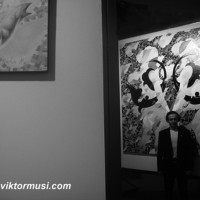 In 2011 “Vianden Castle-Palace”, Grand Duchy of Luxembourg, was held a major retrospective-exhibition of Victor Musi entitled “Twenty-5” dedicated to the 25th anniversary of the artist’s pictorial activity.In this retrospective was presented paintings and drawings, covering all the main periods of the artist from 1996 to 2011: 1990-1995 “green period” 1995-1999 “inner light” period, from 1999 to 2007-period “Onirism “2007-2011 period” Total Obsession “In this retrospective-exhibition was presented a new series of drawings of 2011 – “Anti-Wrinkle”“VIANDEN CASTLE-PALACE.”“Vianden Castle-Palace” was constructed between the 11th and 14th centuries on the foundations of a Roman ‘castellum’ and a Carolingian refuge. It is one of the largest and most beautiful feudal residences of the romanesque and gothic periods in Europe. Until the beginning of the 15th century it was the seat of the influential counts of Vianden who could boast their close connections to the Royal Family of France and the German imperial court. Henry I of Vianden (1220-1250) is known as ‘the Sun Count’ for it is duringhis tenure that the holdings, lifestyle and influence of the House of Vianden reached its zenith. His ancestors were influential in the Ardennes, Eifel and Luxembourg regions for hundreds of years. His wife, Margarete of Courtenay, was of the French Royal Family, daughter of the Latin Emperor of Constantinople, sister-in-law to the King of Hungary and cousin to King Philip-Augustus. Margarete’s ancestors, included the Crusaders from the Houses of Flanders and Hainault, Henry’s and Margarete’s son, Frederic had served in the Fifth Crusade. In 1417, the dominion passed by inheritance to the House of Nassau, which, in 1530 collected the principality of Orange as well. From then on, the castle was no longer the official residence of the counts. People can still see the rich architecture the House of Nassau inherited, as no further modifications were made. It was a pile of rubble until the family of the Grand Duke of Luxembourg transferred it to State ownership in 1977. Since restored to its former glory, the castle now ranks as a monument of not only regional, but European importance. |


